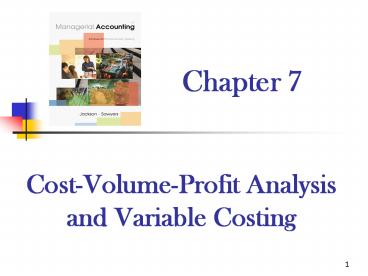Cost-Volume-Profit Analysis and Variable Costing - PowerPoint PPT Presentation
Title:
Cost-Volume-Profit Analysis and Variable Costing
Description:
Cost-Volume-Profit Analysis and Variable Costing ... Even Analysis Break-Even Analysis Break-Even Calculations Using Activity-Based Costing Target Profit ... – PowerPoint PPT presentation
Number of Views:361
Avg rating:3.0/5.0
Title: Cost-Volume-Profit Analysis and Variable Costing
1
Chapter 7
- Cost-Volume-Profit Analysis and Variable Costing
2
Introduction
- Cost-volume-profit (CVP) analysis focuses on the
following factors - The prices of products or services
- The volume of products or services produced and
sold - The per-unit variable costs
- The total fixed costs
- The mix of products or services produced
3
The Contribution Margin Income Statement
The contribution margin income statement is
structured by behavior rather than by
function. Sales - All Variable Costs
Contribution Margin Contribution Margin - All
Fixed Costs Net Income
4
Contribution Margin Per Unit
For every unit change in sales, contribution
margin will increase or decrease by the
contribution margin per unit multiplied by the
increase or decrease in sales volume.
5
Contribution Margin Ratio
Contribution Margin Ratio Contribution Margin
(in ) Sales (in )
6
Contribution Margin Ratio
For every dollar change in sales, contribution
margin will increase or decrease by the
contribution margin ratio multiplied by the
increase or decrease in sales dollars.
7
Break-Even Analysis
Break-Even Point The level of sales where
contribution margin just covers fixed costs and
consequently net income is equal to zero.
8
Break-Even Analysis
Fixed Costs Contribution Margin Per Unit
Break-Even (units)
Break-Even (Sales )
Fixed Costs Contribution Margin Ratio
9
Break-Even Calculations Using Activity-Based
Costing
When using activity-based-costing, costs are
classified as unit, batch, product, or facility
level instead of variable or fixed.
Break-Even (units)
Fixed Costs Batch-Level Costs Product-Level
Costs Contribution Margin Per Unit
10
Target Profit Analysis(Before and After Tax)
To determine the sales units required to achieve
a target profit before taxes
Sales Volume
Fixed Costs Target Profit (before
taxes) Contribution Margin Per Unit
11
The Impact of Taxes
If After-Tax Profit Before-Tax Profit (1-tax
rate) then Before-Tax Profit After-Tax Profit
/ (1-tax rate) Therefore, to determine after-tax
Target Profit
Fixed Costs After-Tax Profit / (1-Tax
Rate) Contribution Margin per Unit
Sales in units
12
The Impact of Taxes
The payment of income tax is an important
variable in target profit and other CVP decisions.
13
Assumptions of CVP Analysis
- Selling price is constant throughout the relevant
range. - Costs are linear throughout the relevant range.
- The sales mix used to calculate the weighted
average contribution margin is constant. - The amount of inventory is constant.
14
Cost Structure and Operating Leverage
Operating Leverage The measure of the proportion
of fixed costs in a companys cost structure. It
is used as an indicator of how sensitive profit
is to changes in sales volume.
15
Cost Structure and Operating Leverage
Contribution Margin Net Income
Operating Leverage
Operating Leverage X Increase in Sales
Increase in Net Income
16
Cost Structure and Operating Leverage
A company operating near the break-even point
will have a high level of operating leverage and
income will be very sensitive to changes in sales
volume.
17
Variable Costing for Decision Making
The only difference between absorption and
variable costing is the treatment of fixed
overhead. Absorption Costing Fixed overhead is
treated as a product cost and expensed when the
product is sold. Variable Costing Fixed overhead
is treated as a period cost and expensed as
incurred.
18
Differences Between Absorption and Variable
Costing
- When units sold equal units produced, net income
is the same under both costing methods. - When units produced exceed units sold, absorption
costing will report higher net income than
variable costing. - When units sold exceed units produced, variable
costing will report higher net income than
absorption costing.































